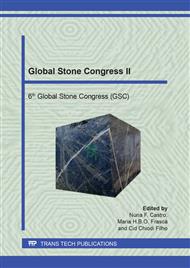[1]
S. Grillo, S. Mocci, G. Pia, N. Spanu, L. Tuveri. Il manuale tematico della pietra. U. Sanna, C. Atzeni (eds), Itaca (pub.), Italy (in Italian), (2009).
Google Scholar
[2]
N. Careddu, S.M. Grillo, Sardinian Basalt—an Ancient Georesource Still En Vogue, Geoheritage 11 (2019) 33-45.
DOI: 10.1007/s12371-018-0285-0
Google Scholar
[3]
G. Siotto, F. Ullu, F., Il settore delle pietre ornamentali in Sardegna. Estrazione, lavorazione e problemi ambientali. Proc. Convegno Pietre sarde: Utilizzo e impatto ambientale,, Promocamera ed., Sassari (Italy) 10.05.1997, (in Italian), (1997).
Google Scholar
[4]
R.A.S., Guida alle Pietre ornamentali della Sardegna. Ed. by Regione Autonoma della Sardegna, Assessorato dell'Industria, Cagliari, Italy (in Italian), (1999).
Google Scholar
[5]
Consorzio 21, Natural stones from Sardinia, Regione Autonoma della Sardegna ed., Bolotana, Italy, (2002).
Google Scholar
[6]
P. Primavori, I materiali Lapidei della Sardegna. Sardegna Ricerche – Regione Autonoma della Sardegna ed., Villaspeciosa, Italy (in Italian), (2011).
DOI: 10.3280/qt2010-039006
Google Scholar
[7]
N. Careddu, M. Scanu, P. Desogus, Map of natural stones from Sardinia. Ed. by authors, Cagliari, Italy (poster), (2015).
DOI: 10.4028/www.scientific.net/kem.848.127
Google Scholar
[8]
R.A.S., Piano Regionale delle Attività Estrattive (PRAE). Regione Autonoma della Sardegna, ottobre 2007. Available from: http://www.regione.sardegna.it/speciali/pianoattivitaestrattive/ (in Italian).
DOI: 10.3280/qt2010-038008
Google Scholar
[9]
G. Minetto. La Sardegna: un'isola di pietra. AZ Marmi, n. 157 (2001), 32-34 (in Italian).
Google Scholar
[10]
P. Primavori, Il Primavori – Stone sector lexicon. Zusi, G., ed., Verona, Italy, (2004).
Google Scholar
[11]
G.P. Cherchi, G. Musumeci, Il Complesso Granitoide della Sardegna Settentrionale. In: L. Carmignani et al., Struttura della Catena Ercinica in Sardegna - Guida all'Escursione,, 157-163, Siena, Italy, 1992 (in Italian).
Google Scholar
[12]
L.G. Costamagna, S. Barca. Stratigraphy, Facies Analysis, Paleogeography and Regional framework of the Jurassic succession of the «tacchi» area (Middle-Eastern Sardinia). Bollettino della Società Geologica Italiana, Vol. 123, Issue 3 (2004), 477-495.
Google Scholar
[13]
L. Carmignani, F.A. Decandia, L. Disperati, P.L. Fantozzi, A. Lazzarotto, D. Liotta, G. Oggiano. Relationships between the Tertiary structural evolution of the Sardinia‐Corsica‐Provençal Domain and the Northern Apennines. Terra Nova, Vol. 7, Issue 2, March 1995, 128-137.
DOI: 10.1111/j.1365-3121.1995.tb00681.x
Google Scholar
[14]
L. Carmignani, S. Barca, L. Disperati, P. Fantozzi, A. Funedda, G. Oggiano, S. Pasci. Tertiary compression and extension in the Sardinian basement. Bollettino di Geofisica Teorica ed Applicata, Volume 36, Issue 141-144 (1994), 45-62.
Google Scholar
[15]
EMSA, Sardinian granites and marbles. Ed. by Ente Minerario Sardo, Cagliari, Italy, (1987).
Google Scholar
[16]
O. Akkoyun, N. Careddu, G. Marras. An investigation of colour properties of Orosei limestones (Italy) by using computer program. Key Engineering Materials Vol. 548 (2013), pp.173-182.
DOI: 10.4028/www.scientific.net/kem.548.173
Google Scholar
[17]
N. Careddu, G. Marras. The effects of solar UV radiation on the gloss values of polished stone surfaces. Construction and Building Materials 49 (2013) 828–834.
DOI: 10.1016/j.conbuildmat.2013.09.010
Google Scholar
[18]
N. Careddu, A. Mazzella, S. Dessì. Surface processing of stone by water-jet: assessment of the minerals' luster and comparison with traditional technologies. Episodes Vol. 40, No. 4 (2017) 305-314.
DOI: 10.18814/epiiugs/2017/v40i4/017031
Google Scholar
[19]
EN 12407:2007. Natural stone test methods — Petrographic examination. March (2007).
Google Scholar
[20]
R.A.S. Carta dei bacini minerari della attività estrattiva in Sardegna (minerali di II categoria). Regione Autonoma della Sardegna, Gruppo EMSA – Progemisa ed., Italy, (in Italian), (1994).
DOI: 10.3280/qt2010-038008
Google Scholar
[21]
N. Careddu, S. Grillo. Rosa Beta granite (Sardinian Pink Granite): a heritage stone of international significance from Italy. From: Pereira, D., Marker, B.R., Kramar, S., Cooper, B.J. & Schouenborg, B.E. (eds), Global Heritage Stone: Towards International Recognition of Building and Ornamental Stones. Geological Society, London, Special Publications, 407 (2015), 155–172.
DOI: 10.1144/sp407.1
Google Scholar
[22]
N. Careddu, G. Marras, G.A. Sanciu. Granite roads in Sardinia: Logudoro Granites at Buddusò. Diamante – Applicazioni & Tecnologia, n. 51, December 2007, 47-56.
Google Scholar
[23]
S. Cuccuru, L. Casini, G. Oggiano, G.P. Cherchi. Can weathering improve the toughness of a fractured rock? A case study using the San Giacomo granite. Bull Eng Geol Environ (2012) 71:557–567.
DOI: 10.1007/s10064-012-0416-9
Google Scholar
[24]
N. Careddu, G. Siotto, G. Marras. The crisis of granite and the success of marble: errors and market strategies. The Sardinian case. Resources Policy 52 (2017) 273–276.
DOI: 10.1016/j.resourpol.2017.03.010
Google Scholar
[25]
N. Careddu, G. Siotto. Promoting ecological sustainable planning for natural stone quarrying. The case of the Orosei Marble Producing Area in Eastern Sardinia. Resources Policy 36 (2011) 304–314.
DOI: 10.1016/j.resourpol.2011.07.002
Google Scholar
[26]
G. Forte, P. Cabiddu. L'industria dei lapidei ornamentali in Sardegna: quadro generale del settore, breve excursus storico e prospettive di sviluppo. In: Atti del Convegno Internazionale su: Situazione e prospettive dell'industria lapidea, Cagliari, 3–5 aprile 1989. Ed. Prestampa, 1992, Quartu S. Elena, Italy (in Italian).
DOI: 10.2307/j.ctv1zcm1x8.61
Google Scholar


